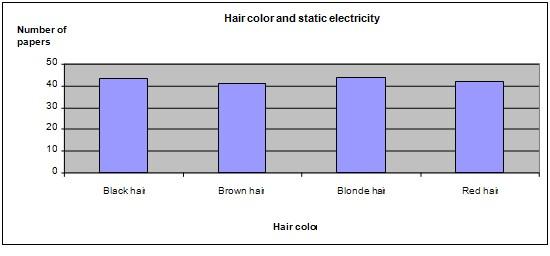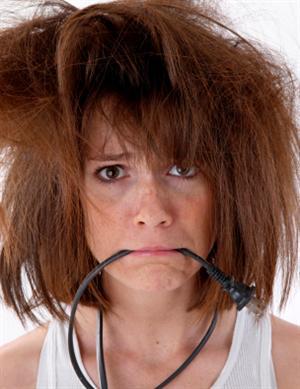| Complexity level: | 5 |
| Project cost ($): | 300 |
| Time required: | 1 hour to prepare, 1 hour for the science project experiment |
| Material availability: | Easily found. You can purchase the wigs from a department store or specialist online stores. Wigs tend to be expensive, so you should try to borrow them from friends or their parents, as far as possible |
| Safety concerns: | None |
Hypothesis
The color of hair does not affect the amount of static electricity it will produce.
Overview
Static electricity
Static electricity is produced when electric charges are accumulated on the surface of an object, for example, the body, or a comb, or a piece of plastic wrap. These charges will be discharged when the object comes into contact with another surface.
When the 2 surfaces rub against each other, friction is produced. Friction causes the transfer of the electrons from the surface that "donates" the electrons to the surface that "captures" the electrons. One material then contains more charges than the other. This imbalance in electric charges between the 2 materials causes static electricity.
Atoms are the building blocks of all matter and they are made of charged particles. Atoms consist of a nucleus which contain neutrons and protons. Atoms also contain electrons which are positioned outside the nucleus.
The ability of an atom to capture or donate an electron determines its place in the triboelectric series, (i.e. a list which shows which materials tend to take on a more positive or negative electric charge when rubbed). An atom that donates its electron will become positively charged and it is said to be more positive in the triboelectric series. An atom that tends to receive an electron becomes negatively charged and is said to be more negative on the triboelectric series.
Scientific Terms
Materials
The materials required for the science fair project:
- 1 balloon
- 1 copper plate 200mm x 300mm
- 1 ground connection
- 1 jumper wire with a crocodile clip at each end
- 1 black hair wig made from natural hair
- 1 brown hair wig made from natural hair
- 1 blond hair wig made from natural hair
- 1 red hair wig made from natural hair
- a flat tray
- 1 ruler
- 1 piece of letter size paper
- 1 pen knife
Procedure
1. For this science fair project, the independent variable is the color of hair tested – black, brown, blond and red hair. The dependent variable is the number of pieces of paper picked up by the balloon. This is determined by counting the number of pieces of paper sticking to the balloon. The constants (control variables) are the size of the balloon, the number of times the balloon in rubbed on the wigs and the weight of the bits of paper.
2. Using the jumper wire, the copper plate is connected to the ground. Using the ruler and pen knife, the letter size paper is cut into small square pieces of paper measuring 5mm x 5mm. The static electricity in the pieces of paper is discharged by placing them on the grounded copper plate. The pieces of paper are then placed on the flat tray.
3. The balloon is inflated and rubbed on the grounded copper plate in order to discharge its static electricity.
4. The black, brown, blond and red natural hair wigs will be used in this science fair project. The thickness and type of hair should be as similar as possiblefor all 3 wigs.
5. First the balloon is rubbed against the black hair wig 6 times in one direction. The charged balloon is then placed on the tray to see how many pieces of paper will attach itself to the balloon.. The pieces of paper attached to the balloon are collected, counted and the number recorded. The test is repeated 5 times and the average number of pieces of paper attached to the balloon is calculated and recorded in the table given below.
6. The static electricity on the pieces of paper and the balloon are then discharged again on the copper plate. Procedure 5 is repeated using the brown, blond and red hair wigs. The average results are calculated and recorded in the table given below.

Results
The results show that the black, brown, blond and red hair wigs produced almost the same amount of electrostatic charges because the average number of pieces of paper picked up by the balloon after it is rubbed against each wig, was almost the same.
| Condition | Number of paper pieces collected | |||
| Black hair | Brown hair | Blonde hair | Red hair | |
| Number of pieces of paper | 43 | 41 | 44 | 42 |
Use the below graph to plot the results of above observation.

Conclusion
The hypothesis that hair color will not affect the amount of static electricity produced is proven to be correct.
Natural hair is made from keratin which is the same type of protein that is also found on nails and skin. The static charges in our hair are carried by keratin. The proteins that determine the color of hair do not affect the ability of the keratin to carry static. Therefore, the color of hair does not influence the amount of static electricity produced by the hair. However, the physical properties of the hair, such as its thickness, can affect the amount of static charge produced on.
Also consider
The experiment can also be done using a comb instead of a balloon.
Try to repeat the experiment using different types of hair like curly, wavy and straight.
What if the hair is wet? Do you think the amount of static electricity produced will be greater or less?
References
Static electricity - http://en.wikipedia.org/wiki/Static_electricity
Static electricity - http://science.howstuffworks.com/vdg1.htm

